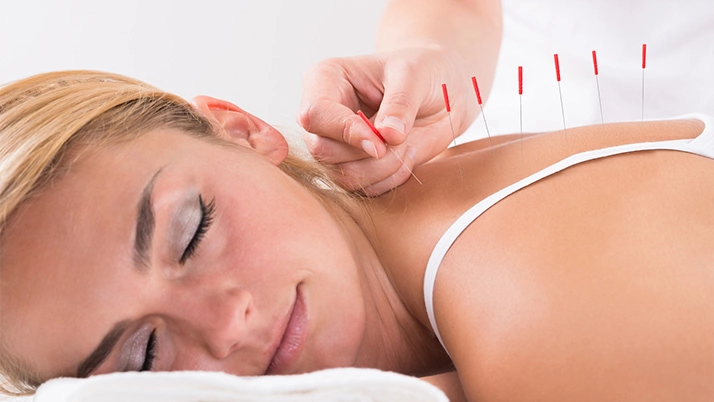How Does Dry Needling Work?

Not all chiropractors are alike. Some chiropractors utilize just one or two techniques to help patients feel better and that often provides lackluster results. Without a wide range of techniques like dry needling, rehab exercises, electrical stimulation, ultrasound, and class 4 laser therapy, patients can be left with little to no progress.
In the article below, our doctor is angry because he just met with a young patient who was in a car accident. This patient was given the same roller table treatment over and over for 15 months and he didn't get any better. The doctor that was treating this patient didn't try anything different, like dry needling or rehab exercises, and this left the patient 15 months into care with no results to show for it. This kind of care, if it can even be called care, is unacceptable.
When you visit a chiropractor because you're in pain or have an injury, your care should be progressive. This means that it should change and adapt over time in response to what is working for you and what isn't working for you. This is exactly why we offer a wide range of treatment techniques from rehab programs to dry needling to spinal decompression.
We attack the problem you're facing with a combination of treatment techniques so you can feel better as fast as possible. Every time you come into our office, we review your progress and evaluate how we can change and improve your treatment plan. This is how we get patients out of pain quickly and help them feel better faster.
Dry needling is one of the treatment techniques we use very frequently and while it may sound painful, it's a painless and quick process. We explained what trigger point dry needling is and how it differs from acupuncture but how does it work exactly?
How Does Dry Needling Work?
Dry needling, also known as trigger point dry needling, is a drug-free treatment that has become increasingly popular because it addresses the root cause of pain without using prescription drugs. The practitioner uses a thin monofilament needle to penetrate the skin and treat underlying muscular trigger points or muscle tension, injuries, and pain. This process has been proven to relieve and improve neuromusculoskeletal pain and movement impairments in many patients.
When muscles are overused or tense, they can develop knotted areas called trigger points. A trigger point holds a lot of tension and it can disrupt function, restrict mobility or range of motion, and cause intense pain and tenderness. Aside from the pain caused by the tension, trigger points also disrupt the blood supply to the muscle. This means the muscle is not receiving the nutrients and oxygen it needs to return to a normal state.
We can stimulate a trigger point by inserting small monofilament needles into it and allowing them to sit in the trigger point for 10-15 minutes. This stimulation results in a rush of blood returning to the area and relieving the tension. While the needles don't hurt, the sensation of having them in your skin can be enough to release endorphins which provide pain relief.
Our patients often compare the effectiveness of dry needling to multiple deep tissue massages, but in a fraction of the time. During a dry needling session, a patient may feel a twitch in the muscle or pressure as it releases tension but they don't feel pain from the needles. Some patients don't even feel the needles enter their skin and just feel a mild ache, twitch, or a feeling of pressure during the treatment.
It's amazing the results patients can get from a short trigger point dry needling session. We determine how long the needles need to be left in the muscle by the type of pain a patient is experiencing. For pain that isn't deep in a muscle, needles may only be left for a few seconds. For more intense, deep muscle pain, we usually leave the needles for 10-15 minutes.
In some cases, patients feel relief during and immediately after dry needling while others feel relief within the 24 hours following their dry needling session. It may take a few sessions to experience sustained pain relief and get the muscle back into its normal resting state, but these sessions are short and painless. Once the muscle is relaxed, we can move on to rehab exercises that will build up muscle strength and help prevent future injuries. This is what progressive care looks like and it's what you should expect from your chiropractor.
Dry needling works wonderfully for many of our patients but it is just one of the many treatment techniques we have available. Every patient we see is different so we create a custom treatment plan for each patient that is reviewed and changed over time. Don't continue to see a physician that isn't willing to change and change your treatment if it is not working.
Are you ready to finally get some relief from your pain and see if dry needling is right for you? Click here or call (410) 296-7700 to schedule your consultation and we'll explain how we can help you feel better faster, even if nothing else has worked before.
IF YOU'D LIKE TO LEARN MORE ABOUT OUR NEWSLETTER, SUBSCRIBE BELOW
FOR MORE INFORMATION, FILL OUT THE FORM BELOW
OFFICE HOURS
Monday
7:30am - 12:00pm
2:00pm - 6:00pm
Tuesday
7:30am - 12:00pm
2:00pm - 6:00pm
Wednesday
7:30am - 12:00pm
2:00pm - 6:00pm
Thursday
7:30am - 12:00pm
2:00pm - 6:00pm
Friday
7:30am - 12:00pm
Saturday & Sunday
Closed
Kalkstein Chiropractic
200 E Joppa Rd #300
Towson, MD 21286